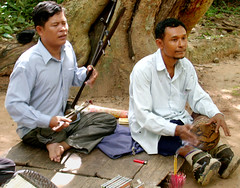
At the close of the Vietnam War, Cambodia became caught in the violence of America’s long and bitter struggle in Southeast Asia. The Viet Cong had taken a stronghold in its jungles when then President Richard Nixon carried out secret bombing raids over the tiny country.
New York Times bureau chief Sydney Schanberg stayed behind in 1975 when helicopters evacuated the U.S. embassy in Cambodia’s capital city of Phnom Penh. The rest of the world was watching a similar scenario in neighboring South Vietnam when the U.S. abandoned Saigon. Few seemed to care about what was happening in Cambodia.
Schanberg’s gripping story about the slaughter of life that followed in Cambodia was told in the 1984 movie, “The Killing Fields,” starring Sam Waterston. It was based on the reporter’s book, “The Life and Death of Dith Pran,” a Cambodian journalist who worked as Schanberg’s assistant.
The story later inspired the novel of the same name as the movie. While the book’s pages have yellowed over time, it’s worth another read today, while America is “spreading Democracy” in a war that seems to have no end in sight in Iraq.
Schanberg’s dispatches to New York revealed how a tiny insurgent group led by the infamous Pol Pot had grown to include thousands of members following the 1973 bombings. The ruler’s Khmer Rouge party stormed Phnom Pehn in the spring of 1975, taking command of the country. It would become responsible for an estimated 1.5 million deaths.
It took several years for Vietnamese troops to quash the regime, only after Pol Pot’s army had littered the country with land mines. Today, Cambodia’s government majority is held by Communists. And its citizens are living a legacy from that conflict where just about every family has lost a member to land mines, or has a relative missing an arm, leg or eye to the devices.
It’s safe now to visit Cambodia, only after millions of dollars in foreign aid have been invested to sweep the landscape of mines.

(Land mine victims make music, above, at the ancient temples of Angkor Wat, Siem Reap, Cambodia)
War follows similar paths. Last month, former army Brig. Gen. Janis Karpinski spoke at California University of Pennsylvania about the need to pull out of a misguided war in Iraq. While serving there in 2004, she said many Iraqis who initially supported U.S. soldiers went on to join the insurgency in hopes of change. This is a war, too, where journalists of Schanberg’s breed are not given the opportunity to send home the full story.

No comments:
Post a Comment